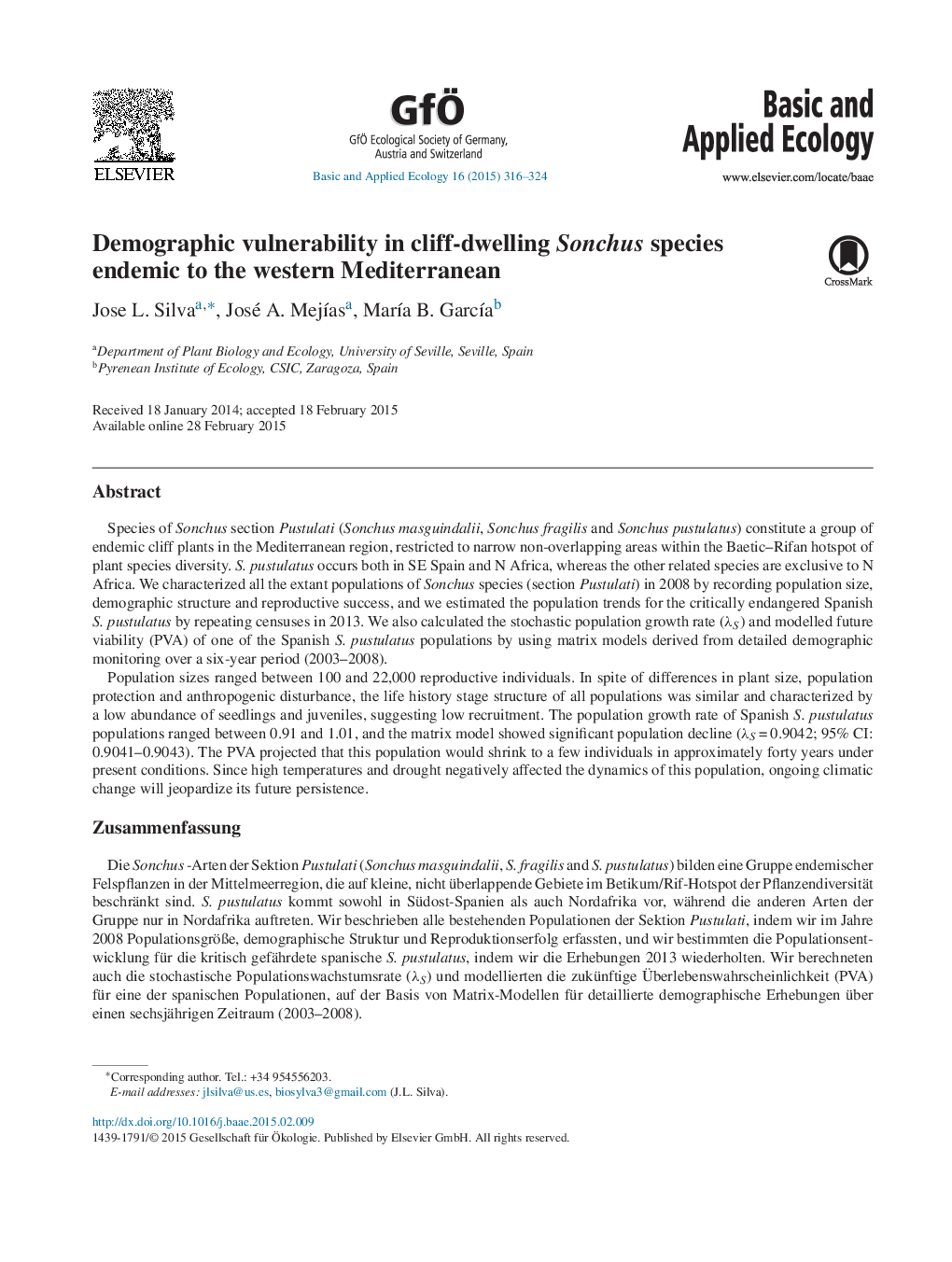| کد مقاله | کد نشریه | سال انتشار | مقاله انگلیسی | نسخه تمام متن |
|---|---|---|---|---|
| 4384099 | 1304389 | 2015 | 9 صفحه PDF | دانلود رایگان |
Species of Sonchus section Pustulati (Sonchus masguindalii, Sonchus fragilis and Sonchus pustulatus) constitute a group of endemic cliff plants in the Mediterranean region, restricted to narrow non-overlapping areas within the Baetic–Rifan hotspot of plant species diversity. S. pustulatus occurs both in SE Spain and N Africa, whereas the other related species are exclusive to N Africa. We characterized all the extant populations of Sonchus species (section Pustulati) in 2008 by recording population size, demographic structure and reproductive success, and we estimated the population trends for the critically endangered Spanish S. pustulatus by repeating censuses in 2013. We also calculated the stochastic population growth rate (λS) and modelled future viability (PVA) of one of the Spanish S. pustulatus populations by using matrix models derived from detailed demographic monitoring over a six-year period (2003–2008).Population sizes ranged between 100 and 22,000 reproductive individuals. In spite of differences in plant size, population protection and anthropogenic disturbance, the life history stage structure of all populations was similar and characterized by a low abundance of seedlings and juveniles, suggesting low recruitment. The population growth rate of Spanish S. pustulatus populations ranged between 0.91 and 1.01, and the matrix model showed significant population decline (λS = 0.9042; 95% CI: 0.9041–0.9043). The PVA projected that this population would shrink to a few individuals in approximately forty years under present conditions. Since high temperatures and drought negatively affected the dynamics of this population, ongoing climatic change will jeopardize its future persistence.
ZusammenfassungDie Sonchus -Arten der Sektion Pustulati (Sonchus masguindalii, S. fragilis and S. pustulatus) bilden eine Gruppe endemischer Felspflanzen in der Mittelmeerregion, die auf kleine, nicht überlappende Gebiete im Betikum/Rif-Hotspot der Pflanzendiversität beschränkt sind. S. pustulatus kommt sowohl in Südost-Spanien als auch Nordafrika vor, während die anderen Arten der Gruppe nur in Nordafrika auftreten. Wir beschrieben alle bestehenden Populationen der Sektion Pustulati, indem wir im Jahre 2008 Populationsgröße, demographische Struktur und Reproduktionserfolg erfassten, und wir bestimmten die Populationsentwicklung für die kritisch gefährdete spanische S. pustulatus, indem wir die Erhebungen 2013 wiederholten. Wir berechneten auch die stochastische Populationswachstumsrate (λS) und modellierten die zukünftige Überlebenswahrscheinlichkeit (PVA) für eine der spanischen Populationen, auf der Basis von Matrix-Modellen für detaillierte demographische Erhebungen über einen sechsjährigen Zeitraum (2003–2008).Die Populationsgrößen variierten zwischen 100 und 22,000 reproduktiven Individuen. Trotz Unterschieden in der Pflanzengröße, im Schutzstatus und bei anthropogenen Störungen war die Altersstruktur in allen Populationen ähnlich und charakterisiert durch geringe Abundanzen von Sämlingen und Jungpflanzen, was auf geringe Rekrutierung hinweist. Die Wachstumsraten der spanischen S. pustulatus-Populationen rangierten zwischen 0.91 und 1.01, und das Matrix-Modell zeigte eine signifikante Populationsabnahme (λS = 0.9042; 95% CI: 0.9041–0.9043). Die PVA ergab, dass diese Population bei gleich bleibenden Bedingungen in ungefähr 40 Jahren auf wenige Individuen zusammenschrumpfen wird. Da hohe Temperaturen und Trockenheit die Entwicklung dieser Population negativ beeinflussen, wird der gegenwärtige Klimawandel ihr Fortbestehen gefährden.
Journal: Basic and Applied Ecology - Volume 16, Issue 4, June 2015, Pages 316–324
